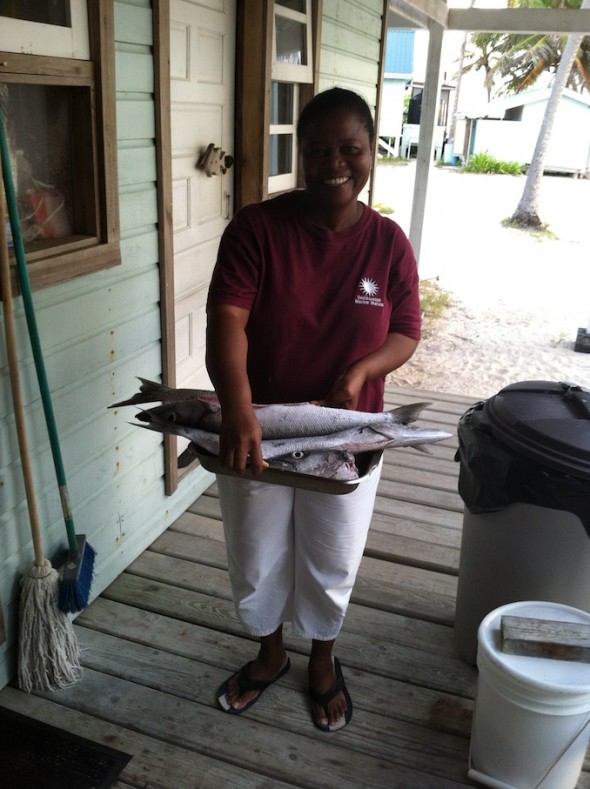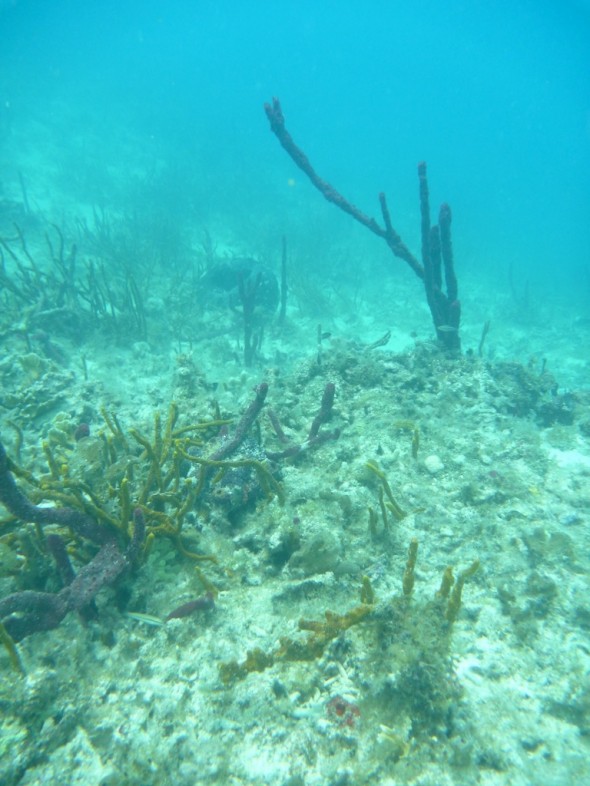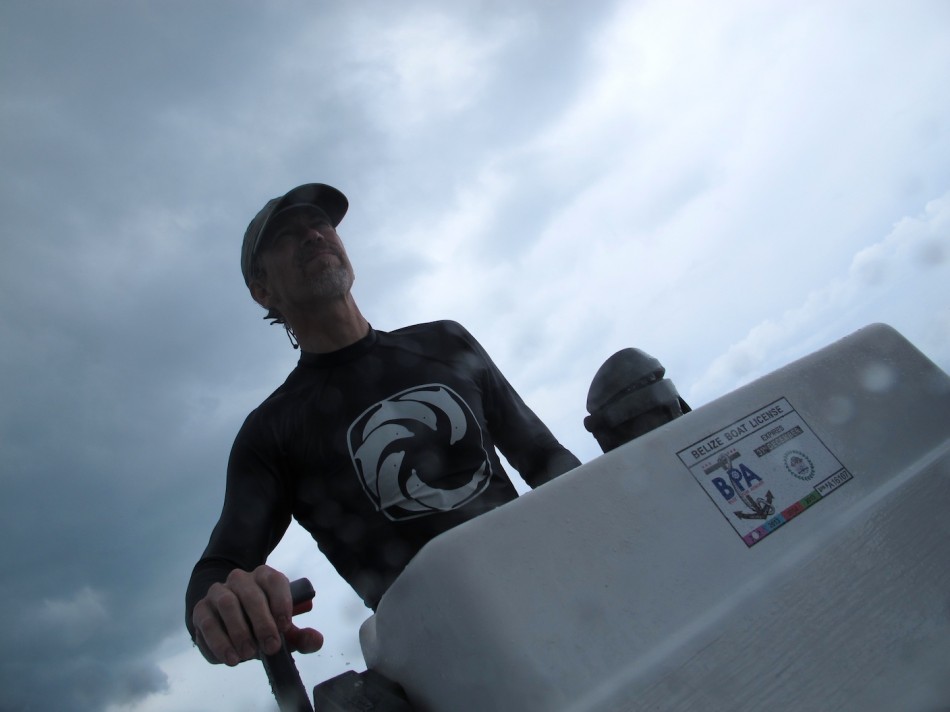[The fourth installment, and I’ll confess my favorite, in our New York Times “Scientist at Work” field log.]
Sunday, July 8
As the sun breaks the horizon, I sit in a wooden chair at the edge of the backreef, an eye on the weather horizon, gratefully sipping the first strong coffee and gauging what the day has in store. Soothed by the fresh breeze and the muffled thud of the surf on the reef, half-watching a lone frigate bird high overhead and a hermit crab lumbering past my bare foot through a miniature jungle of beach vines and flotsam, it feels like home. It’s my 14th trip to this speck of land at the ocean’s edge, and this has been my morning ritual for years, a rare quiet spot in the tumbling stream of modern life to let the mind unreel and reflect.
We are now fully shifted into Plan B mode. The social shrimps that we came searching for, that have dominated these reefs for at least 20 years, are gone. Scrambling to shift course, we put together a hasty plan to document the change quantitatively. Yesterday morning we began carrying out that plan, collecting 10 bags of coral rubble from the first of six reefs to be sampled and spending the afternoon in the rustic lab, sorting out our quarry. The diving is sublime — idyllic seascapes of coral boulders over brilliant white sand and turtle grass, swaying soft corals and rope sponges, mounds of finger coral in the bright shallows. Fish are plentiful, shoals of grunts and surgeonfish flowing over the reef contours, even a sea turtle foraging over the top of one reef. Back at the lab it’s a laborious process getting under the surface, into the little-known center of biodiversity within the reef structure. But we’re rewarded by a constant stream of small surprises: bizarre undulating flatworms, a rainbow-colored sea slug, a tiny octopus that flashes iridescent color changes like a hallucination. And then there is the abundance of small shrimp.
Today is another marathon. We sample two reefs, taxing work in the choppy weather and strong surge, inhale a hearty lunch prepared by our wonderful cook, Martha, and then switch into lab mode for the long haul of extracting the tiny, elusive shrimp from the sponges and processing them. Our five-member team is now a well-oiled machine, working in assembly-line mode, each with a specific responsibility. This includes identifying shrimp under the microscope, removing subsamples for DNA analyses of genetic relatedness and social structure, measuring and preserving samples of the sponges they came from and carefully documenting all collection data. Even with the efficient division of labor, we’re all seeing double with exhaustion by the time we batten down the lab windows and turn out the light around midnight. This is our routine, from 7:30 a.m. until near midnight for eight days, a point that frequently seems lost when I tell people I’m away for a research trip to the reefs of the Caribbean.
In the morning, I return to my station by the backreef for a few minutes of quiet at daybreak. Strong wind from the southeast, overcast skies and intermittent drizzle. But no lightning so far. We can work. Looking back through my records from more than a decade, I calculate that 75 percent of our shrimp collections in this area consisted of social species — three out of every four specimens we collected. Now there are none, save for a few small colonies of one partly social species. It’s extraordinary. The finding puts into perspective a parallel and also puzzling pattern that we observed in Jamaica. Sampling there in 2008, we found abundant large colonies of social shrimp, but earlier this year colonies were few and much smaller in size. On the Caribbean side of Panama, our colleagues noted a similar disappearance of one of the social species over a few short years.
It now seems clear that a regional decline of social shrimp is under way. And it’s part of a larger pattern of change. Below the deceptively sunny surface of the tropical sea, the loss of social shrimp is only the latest signal of a global ocean ecosystem on the brink of profound change. I and my colleagues everywhere have watched with alarm the astonishingly rapid transformation of the world’s coral reefs, the crown jewels of the planet’s encompassing ocean, over little more than a single human generation. When I began graduate school in 1985, the transformation was only just dawning on us. Most of us got into this business because of what can only be called a love affair with the ocean and its life. But we have been drawn into the unwelcome role of witnessing and documenting the death spiral of reefs and struggling to find some hope for keeping them alive.
As Roger Bradbury wrote bluntly in an Op-Ed article in The New York Times a few days ago, that hope is proving to be a phantom. Coral reefs are dying at our own hands. The murder weapons — fossil fuel consumption and food production — are the basic engines of human economic growth. Relentless harvesting of grazing fishes releases algae and seaweeds that overgrow corals. Rising global temperatures, guaranteed for decades to come by the legacy of greenhouse gases we’ve already released, are already killing corals, which typically live near their upper thermal tolerances. The acidification of the ocean by the same greenhouse gas emissions is expected to dissolve the coral skeletons that create reefs in the first place. Once that complex structure erodes, we are left with flat rock pavements covered by scrubby algae, and biodiversity is accordingly reduced to a fraction of what a healthy reef supports.
Why worry about saving reefs? We frequently hear that they protect coastlines, support tourism and fisheries in the developing world and influence the global carbon budget. These are all true enough and important. But we really care about reefs, we fear for them, because they are exquisitely beautiful and magical undersea gardens of Eden, full of almost unimaginable life-forms that wake something essential in us. They show us, more than perhaps any other ecosystem, what the primeval fire of life is capable of, what it has in fact done over incomprehensible time spans, which we are now undoing permanently. My fear is that more of us are growing up estranged from the benefits of wild nature and, lacking personal experience of their value, will not even know what we are losing, much less work to preserve and nurture it.
The shrimp we study are admittedly only small players in the drama of the reef, but they are bellwethers of the fundamental changes under way all around us. Our hope is that the new research direction that circumstances have forced on us will help provide some answers to what is driving that change and where we’re headed.




Leave a Reply